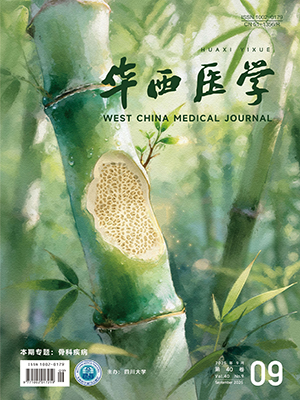| 1. |
王颜颜, 李凌竹, 程敏, 等. 2022 年贵州省 186 所医疗机构医院感染横断面调查报告. 中国感染控制杂志, 2023, 22(10): 1246-1252.
|
| 2. |
任南, 文细毛, 吴安华. 2014 年全国医院感染横断面调查报告. 中国感染控制杂志, 2016, 15(2): 83-87.
|
| 3. |
刘丹, 郭玉香, 张兰兰, 等. 某综合医院住院患者医院感染现患率调查与危险因素分析. 安徽预防医学杂志, 2023, 29(4): 275-279.
|
| 4. |
杨剑税, 闵琦芬, 龚晓文, 等. 江苏某三级医院 2013—2022 年医院感染现患率调查. 江苏预防医学, 2023, 34(2): 192-194, 225.
|
| 5. |
李瑛, 陈岚, 肖维俊, 等. 四川省医院感染经济负担研究. 华西医学, 2020, 35(8): 954-957.
|
| 6. |
杨欣雨, 王惠, 吕宇, 等. 2018—2022 年四川省医院医院感染现况调查. 中华医院感染学杂志, 2023, 33(21): 3201-3206.
|
| 7. |
张磊, 唐婷, 杨滢, 等. 云南省 203 家医疗机构医院感染横断面调查分析. 中国消毒学杂志, 2022, 39(6): 452-455, 460.
|
| 8. |
中华人民共和国卫生部. WS/T 312-2009 医院感染监测规范, 2009.
|
| 9. |
中华人民共和国卫生部. 医院感染诊断标准(试行). 中华医学杂志, 2001, 81(5): 314-320.
|
| 10. |
中华人民共和国卫生部. 医院管理评价指南 (2008 年版). 北京, 2008: 5.
|
| 11. |
Wang JC, Liu F, Tartari E, et al. The prevalence of healthcare-associated infections in mainland China: a systematic review and meta-analysis. Infect Control Hosp Epidemiol, 2018, 39(6): 701-709.
|
| 12. |
朱熠, 赵霞, 潘颖颖, 等. 某综合医院住院患者医院感染现患率的变化趋势分析. 中国消毒学杂志, 2020, 37(2): 105-107.
|
| 13. |
李诗文, 金盈月, 刘乙杉, 等. 2012—2020 年某三甲医院医院感染现患率调查. 中华医院感染学杂志, 2021, 31(22): 3474-3478.
|
| 14. |
肖佳庆, 林玲, 任慧, 等. 2018 年黑龙江省 74 所医院医院感染现患率调查. 中华医院感染学杂志, 2020, 30(10): 1569-1573.
|
| 15. |
张国杰, 孙芳艳, 郭勤, 等. 某三甲医院 2014—2018 年医院感染现患率调查. 中国感染控制杂志, 2019, 18(12): 1116-1120.
|
| 16. |
Salmanov AG, Vdovychenko SY, Litus OI, et al. Prevalence of health care-associated infections and antimicrobial resistance of the responsible pathogens in Ukraine: Results of a multicenter study (2014-2016). Am J Infect Control, 2019, 47(6): e15-e20.
|
| 17. |
吴安华, 文细毛, 李春辉, 等. 2012 年全国医院感染现患率与横断面抗菌药物使用率调查报告. 中国感染控制杂志, 2014, 13(1): 8-15.
|
| 18. |
宫雅琪. 武汉地区 2010—2016 年医院感染横断面调查研究. 武汉: 华中科技大学, 2018.
|
| 19. |
樊雯婧, 蒙定武, 楼冬洁, 等. 2014—2018 年海南地区各级医院住院患者医院感染现患率. 中国感染控制杂志, 2021, 20(4): 333-339.
|
| 20. |
Abulhasan YB, Abdullah AA, Shetty SA, et al. Health care-associated infections in a neurocritical care unit of a developing country. Neurocrit Care, 2020, 32(3): 836-846.
|
| 21. |
陶西萍, 赵娜, 薛卫宁. 2021 年西安市 62 家医疗机构医院感染现患率调查. 中国消毒学杂志, 2022, 39(11): 830-833.
|
| 22. |
王春华, 张磊, 张牣, 等. 40 家医院住院患者医院感染现患率调查. 中国消毒学杂志, 2022, 39(6): 430-433, 437.
|
| 23. |
李凌竹, 冷应蓉, 查筑红, 等. 某医院重症监护病房多重耐药菌目标监测结果分析. 中国消毒学杂志, 2016, 33(5): 441-442, 445.
|
| 24. |
刘华, 邹叔骋, 黄红星, 等. 神经外科手术患者医院感染的临床特点及危险因素. 西部医学, 2019, 31(2): 274-277.
|
| 25. |
马静, 张晓晓, 周永红, 等. 2018—2022 年郑州地区部分三甲医院医院感染监测结果分析. 华南预防医学, 2023, 49(10): 1339-1342.
|
| 26. |
曾翠, 任南, 黄勋, 等. 湘雅医院 15 年间医院感染现患率调查. 中国感染控制杂志, 2016, 15(6): 367-373.
|
| 27. |
刘欢, 刘华, 朱华云, 等. 2014—2018 年某三甲综合性医院医院感染现患率调查. 中国消毒学杂志, 2020, 37(1): 37-39.
|
| 28. |
刘卫平, 赵宇平, 杨永芳, 等. 内蒙古地区医院感染现患率调查分析. 中国感染控制杂志, 2019, 18(6): 531-537.
|
| 29. |
舒明蓉, 黄文治. 2012~2018 年四川大学华西医院感染现患率的趋势分析. 中国循证医学杂志, 2020, 20(7): 759-763.
|
| 30. |
宋海瑞, 刘春, 肖思涵, 等. 预防应用抗菌药物对骨科内固定物Ⅰ类切口手术部位感染的效果分析. 中国消毒学杂志, 2023, 40(10): 749-751, 756.
|
| 31. |
Finn J. Application of SBDD to the discovery of new antibacterial drugs. Methods Mol Biol, 2012, 841: 291-319.
|
| 32. |
国家卫生健康委员会. 2021 年国家医疗服务与质量安全报告. 北京: 科学技术文献出版社, 2021.
|




